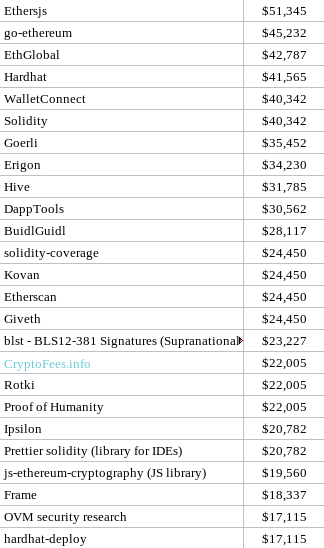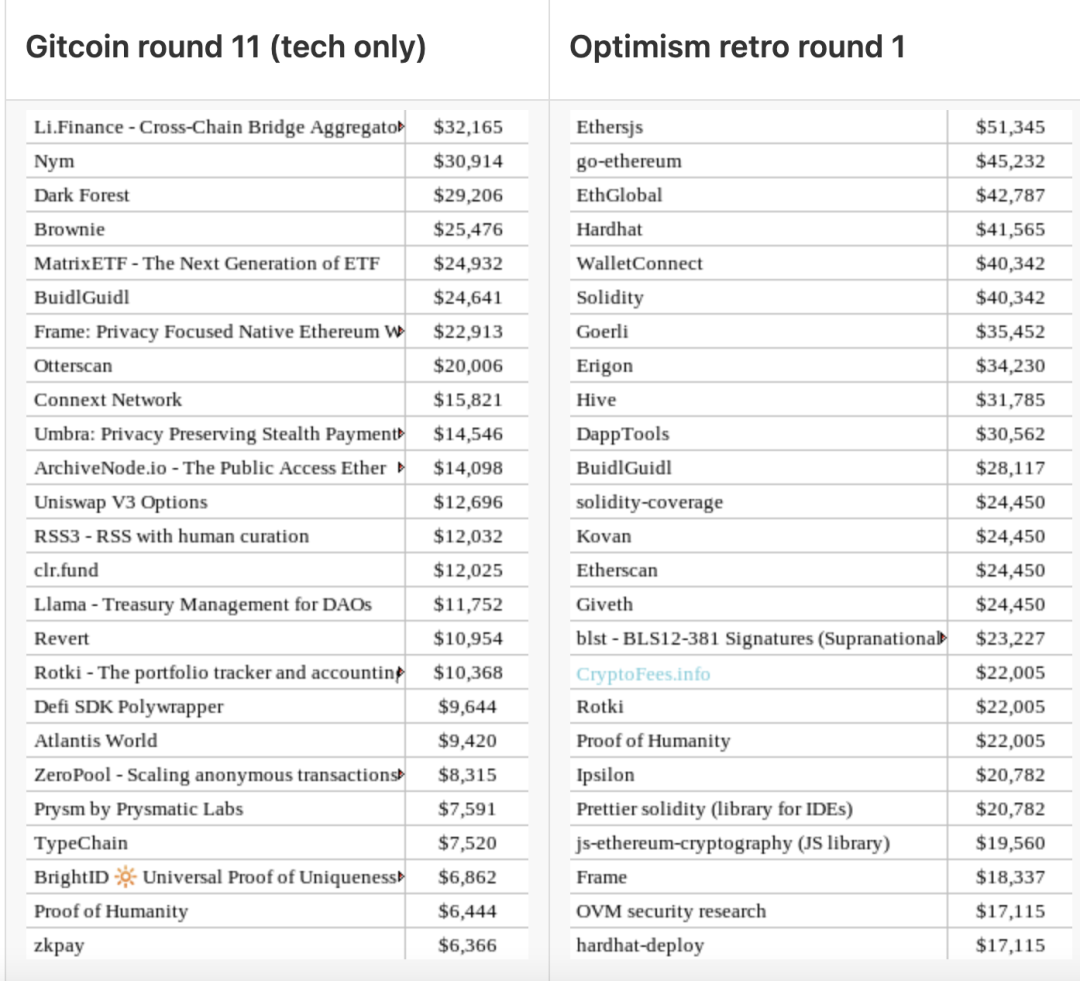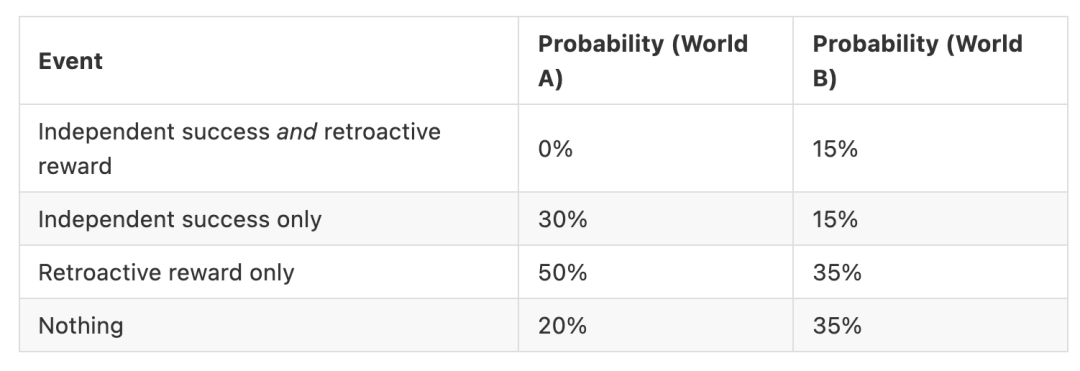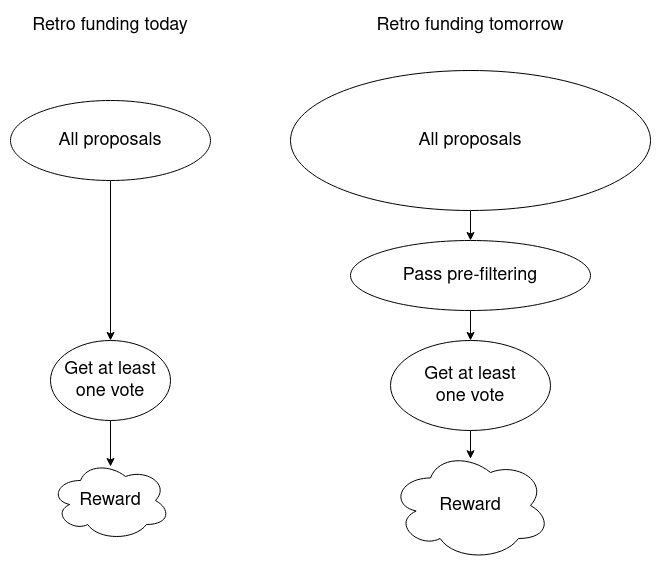Original Author: Vitalik Buterin
Original Author: Vitalik Buterin
Special thanks to Karl Floersch and Haonan Li for feedback and review, and Jinglan Wang for discussion.
Last month, Optimism, the Ethereum Layer 2 solution development team, conducted its first round of retroactive public product funding, distributing a total of $1 million in funding to 58 projects to reward those projects that have already done for Optimism and the Ethereum ecosystem. excellent work. In addition to being the first major retrospective general public goods funding experiment, it is also the first experiment with a new kind of governance by badge holders (rather than by a very small decision-making committee), nor is it a complete An open vote, but a quadratic vote by a medium-sized group of 22 participants.
The entire decision-making process is highly transparent from start to finish:
The rules that badge holders should abide by are written in the holder manual
You can see the nominated projects in this spreadsheet
All discussions among badge holders take place in publicly viewable forums. In addition to Twitter conversations (e.g. Jeff Coleman's post and others), all explicitly structured discussion channels are publicly visible: the #retroactive-public-goods channel on the Optimism Discord, and Zoom calls that have been held
Full results can be viewed in this spreadsheet along with individual badge holder votes entered into the results

Finally, here are the results of the allocation of funds presented in graph form for easy reading:
1
Much like the Gitcoin quadratic funding round and the MolochDAO grants program, this is yet another example of the Ethereum ecosystem becoming a key player in the design of funding mechanisms for innovative public goods. But what can we learn from this experiment?
analysis results

First, let's see if there is anything interesting that we can analyze by looking at the results. What are we comparing these results to in the first place? One of the most natural points of comparison is the other major public good funding experiment we’ve done to date: the Gitcoin Quadratic funding round (in this case, the Gitcoin Giving Program Round 11).
Perhaps the most obvious attribute of the Optimism retro grant results that can be seen in the absence of any comparison is the category of winners: every major Optimism retro grant winner is a technology-based project. Nothing is specified in the badge holder's description; non-technical items (e.g. translations on ethereum.cn) definitely qualify. However, due to some combination of badge holder choice and subconscious bias, this round seems to be interpreted as technology-oriented. Therefore, I restricted the Gitcoin results in the table above to technologies ("DApp Technologies" + "Infrastructure Technologies") to focus on the remaining differences.
Some other major differences are:
There was very little variation in the size of funding received by projects in retrofunding: the top-funded project was only three times (indeed, exactly three times) more funded than the 25th-ranked project, while when combining the two categories In the Gitcoin chart, the gap is more than 5 times, and if you look at DApp Tech or Infra Tech, the gap is more than 15 times! I personally blame this on Gitcoin's use of standard quadratic funding() and retro funding of unused squares; maybe the next retro funding round should just add squares.
Winners of retro rounds are better known projects: this is actually an expected outcome: retro rounds focus on rewarding projects that already provide value, while Gitcoin rounds are open-ended, with many contributions to promising new expected value of the project.
The retro round focuses more on infrastructure, the Gitcoin round focuses more on more user-facing projects: this is of course a generalization, as there are a lot of infrastructure projects on the Gitcoin list, but in general, direct user-facing applications compare protrude. A particularly interesting result (or reason?) is that Gitcoin rounds focus more on projects that are attractive to sub-communities (e.g. gamers), while retro rounds focus more on projects of global value - or less charitable ones projects, a special sub-community is the Ethereum Developers.
It's my own (and I admit very subjective) opinion that the retro round winner selection is of a higher quality. This has nothing to do with the three differences above; the more general impression is that the particular program selected as the top recipient on the right is of very high quality, by a large margin, than the top recipient on the left.
2
Of course, there could be two reasons for this: (i) fewer but more skilled badge holders ("technologists") can make better decisions than the "general population", and (ii) retroactive financing is more efficient than early Judging project quality is easier. This brings us to an interesting question: If there was one simple way to summarize most of the above findings, it would be that technologists (eg. badge holders) are smarter, but crowds (eg. . Gitcoin funding participants) more diverse?
Can we make badge holders and their outputs more diverse?

To better understand the problem, let's zoom in on a specific example already mentioned above: ethereum.cn. This is an excellent Chinese Ethereum community project (not the only one! See also EthPlanet), which has been providing a large number of Chinese resources for people to learn about Ethereum, including translations of many technical articles written by members of the Ethereum community.
Ethereum.cn website. Plenty of high-quality technical stuff - although they haven't gotten the memo that "eth2" should be renamed "consensus layer". Subtract ten retroactive bonus points for them.
What knowledge does a badge holder need to have to effectively judge whether ethereum.cn is a great project, a well-meaning but mediocre project that few Chinese people actually visit, or a scam? Probably as follows:
Able to speak and understand Chinese
Get involved in the Chinese community and understand the social dynamics of that particular project
Sufficient understanding of the mindset of technical and non-technical readers to judge the usefulness of the site to them
Among current US-focused badge holders, the number who meet these requirements is essentially zero. Even the two Chinese-speaking badge holders are American and not close to the Chinese Ethereum community.
So what happens if we expand the badge holder population? We could add five badge holders from the Chinese Ethereum community, five from India, five from Latin America, five from Africa, and five from Antarctica to represent penguins. At the same time, we can also diversify in areas of expertise: some technologists, some community leaders, some people who join the Ethereum gaming world. Hopefully we get enough coverage that for every project of value to Ethereum we have at least 1-5 badge holders who know enough about the project to be able to vote on it intelligently. But then we see the problem: only 1-5 badge holders can vote on it sensibly.
I see several solution families:
Adjust quadratic voting design. In theory, quadratic voting has the unique property that there is little incentive to vote on items you don't understand. Any votes you make take away points you can use to vote on items you understand better. However, the current quadratic voting design has a flaw: not voting for a project is not really a neutral no-vote, it is a vote for the project to get nothing. I don't have a good idea on how to do this yet. A key question is: if 0 becomes a truly neutral vote, how much does a project get if no one votes on it at all? However, this deserves more research.
Divide votes into categories or subcommittees. Badge holders first vote to sort projects into buckets, the badge holders in each bucket ("zero-knowledge proof", "game", "India"...) and then make a decision from there. This can also be done in a more "liquid" way through delegation - a badge holder can choose some other badge holders to decide their vote on a project, and they will automatically replicate their vote.
first level title
3
first level title
The means-test debate
One of the key questions raised during retrospective funding review discussions for badge holders was: Should a badge holder, when choosing which projects to fund, consider whether the project is already well-funded?
In "regular" grant funding rounds, the answer to "yes" is clear: increasing a project's funding from $0 to $100,000 has more impact on its ability to get the job done than increasing a project's funding from $10 million to $1010 Ten thousand U.S. dollars. But the first round of Optimism retroactive funding is not regular grant funding. In retroactive funding, the goal is not to give people money in the hope that the money will help them do future work. Instead, the goal is to reward people for the work they've already done, changing the incentives for anyone working on the project in the future. With this in mind, how much should retroactive project funding depend on how much money is actually needed for a given project?
The case for priority needs
Let’s say you’re a 20 year old developer and you’re deciding whether to join some well-funded defi project, hold a fancy token, or do some cool open-source fully pro bono work that will benefit everyone. If you join a well-funded defi project, you will get a salary of $100,000 and your finances will be secured. If you work on pro bono projects yourself, you will have no income. You have some savings, and you can make some money part-time, but it's going to be difficult, and you're not sure if the sacrifice is worth it.
Now, consider two worlds, world A and world B. First, the similarities:
There are ten people exactly like you who are likely to be retroactively rewarded, and there are only five places. Therefore, you have a 50% chance of being rewarded retroactively.
There is a 30% chance that your work will propel you to modest fame and you will get hired by some company on better terms than the original defi project (or even start your own project).
Now, the diff:
World A (Sentiment Check): Retroactive rewards focus on projects that didn't succeed by other means
World B (no means test): Retroactive rewards are issued regardless of whether the project was otherwise successful

Let's take a look at your opportunities in each world.
So if we want to encourage people in this hypothetical 20-year-old position to actually contribute, it seems prudent to concentrate retroactive rewards on projects that have not yet been rewarded by other means.
text
The Case Against Prioritizing Needs
Suppose you are someone who contributes small amounts of money to many projects, or an investor who seed-funds public goods projects in hopes of receiving retroactive rewards. In this case, your share of any single retroactive reward is very small. Would you rather have a 10% chance of getting $10,100, or a 10% chance of getting $10,000 and a 10% chance of getting $100? It really doesn't matter.
Means tests have their own drawbacks. This will require badge holders to expend effort to determine how well-funded the project is beyond the retroactive reward system. This can lead to projects spending a lot of effort hiding their wealth and appearing scrappy to increase their chances of getting more rewards. Subjective assessments of recipient needs could turn into politicized assessments of recipients' moral worth, making the mechanism even more controversial. In extreme cases, a complex tax reporting system may be required to properly enforce fairness.
text
In general, there seems to be some prioritization of projects where the business model is not found to be advantageous, but we shouldn't do too much. Projects should be judged first and foremost by their impact on the world.
4
to nominate
to nominate
In this round, anyone can submit a project to be nominated via a Google form, and only 106 projects were nominated. Now that people are convinced they have a chance at thousands of dollars in payouts, what about the next round? In a hypothetical future year, when fees from millions of daily transactions are paid into retroactive funding rounds, individual projects receive more funding than entire rounds today, what about that year?

Some kind of multi-tiered nomination structure seems inevitable. It may not be necessary to write it directly into the voting rules. Instead, we can think of it as an ad hoc way of changing the structure of the discussion: the nomination rules filter out the nominations that the badge holder needs to see, and anything the badge holder doesn't see will default to zero votes (unless the badge Holders really care about getting around the rules because they have their own reasons to believe that certain items are valuable).
Some possible ideas:
Badge holder pre-approval: For a proposal to be visible, it must be approved by N badge holders (eg N=3?). Any N badge holder can pre-approve any project; this is an antispam speed bump, not a gatekeeping subcommittee.
Requiring proposers to provide more information about their proposal, justifying it and reducing the work required for work badge holders to complete it. Badge holders will also appoint a separate committee and entrust it with sorting the proposals and forwarding those that comply with the rules and pass the basic smell test for non-spam
Proposals must specify a category (e.g. "Zero-Knowledge Proofs", "Games", "India"), and badge holders who identify themselves as experts in that category will review these proposals and only if they choose the correct category and pass the basic smell test.
Proposals require a proof-of-humanity ID, with a maximum of 3 proposals per person. If your proposal receives 0 votes (or: if any of your proposals are explicitly considered "spam"), you cannot submit further proposals (or you must provide a deposit) for one year.
5
Conflict of Interest Rules
Conflict of Interest Rules
The first part of the post-round retrospective discussion is a discussion of conflict of interest rules. Badge holder instructions include the following terms:
6) No self-dealing or conflict of interest
RetroDAO governance participants should refrain from voting to send funds to any portion of those funds that are expected to go to their organization, their other projects, or anyone with whom they have a close personal or financial relationship.
Wording issues lead to confusion. Some badge holders are wondering about the word "other": Can badge holders use funds directly for their own primary projects? Also, the language "sending funds to the organization" does not strictly prohibit direct transfers to oneself. These are arguably simple mistakes in writing this clause;"other"The word should be deleted,"organize"replace with"address"。
address
What if the badge holder is part of a nonprofit that itself provides grants to other projects? Can badge holders vote for that nonprofit? Badge holders will not benefit as the funds are 100% passed on to others, but they can benefit indirectly.
What level of association counts as close association? Ethereum is a tight-knit community, and those qualified to judge the best projects are usually friends of the team at least to some extent, or are personally involved with these projects precisely because they respect them. When do these associations cross the line?
6
I don't think there is a perfect answer to this. Instead, this line will inevitably turn gray and can only be discussed and refined over time. The main mechanic design tweaks that could mitigate it are (i) increasing the number of badge holders, diluting the fraction of them who can be insiders on any single project, (ii) reducing reward support for projects with only a few badge holders ( My suggestion above to set the reward to not would also help here), and (iii) make sure badge holders can counteract obvious abuse when they do show up.
Should badge holders vote be a secret ballot?
Voting by badge holders in this round is completely transparent; anyone can see how each badge holder voted. But transparent voting has a huge downside: it is susceptible to bribery, including the kind of informal bribery to which even good people are prone to succumb. Badge holders may end up supporting projects, in part to win their favor. More realistically, badge holders may be reluctant to downvote even with valid reasons, since public downvoting can easily damage relationships.
The secret ballot was the natural choice. Secret ballots are widely used in democratic elections, where any citizen (or sometimes a resident) can vote, precisely to prevent more coercive forms of ticket buying and influence how people vote. In a typical election, however, voting within the executive and legislature is usually open. The usual reason for this has to do with democratic accountability theory: Voters need to know how their representatives voted so they can choose their representatives and know they are not outright lying about their values. But accountability also has a dark side: Elected officials conducting public votes are held accountable to anyone who tries to bribe them.
Secret ballots within government agencies do have precedent:
Knesset uses secret ballot to elect president and several other officials
Secret ballots are used in various contexts in the Italian Parliament. In the 19th century it was considered an important way of protecting parliamentary votes from interference by the monarchy.
Before 1970, discussions in the U.S. Congress were less transparent, and some researchers believe that the shift to greater transparency led to more corruption.
Jury votes are usually conducted in secret. Sometimes, even the identities of jurors are kept secret.
Overall, the conclusion seems to be that secret ballots in government agencies have complex consequences; it's not clear that they should be used anywhere, but it's also not clear that transparency is an absolute good.
Especially in the context of Optimism's retroactive funding, the main specific argument I've heard against secret ballots is that it makes it harder for badge holders to band together to vote against other badge holders that are clearly very wrong or even malicious of. Today, if some rogue badge holders start supporting a project that provides no value and is clearly a cash grab for those badge holders, other badge holders can see this and vote against it to neutralize the attack . For secret ballots, it is unclear how this will be done.
7
I'm personally in favor of a second round of Optimism retroactive funding (unless perhaps open to a small number of researchers in private) using a fully secret ballot so that we can see a substantial difference in results. Given the current small and tight-knit badge holder size, dealing with rogue badge holders may not be a major concern, but it will be in the future; therefore, coming up with secret ballot designs that allow counter-voting or other alternative strategies is an important research question.
Additional Ideas for Structured Discussion
Badge holder participation is very uneven. Some (notably Jeff Coleman and Matt Garnett) put a lot of effort into their participation, publicly expressing their detailed reasoning in Twitter threads, and helping to build calls for more detailed discussions. Others participated in discussions on Discord, and still others just voted and did nothing else.
Those two factors combined meant there wasn't as much discussion; certainly less than I'd hoped for. What are some ways to encourage more discussion?
some thoughts:
some thoughts:
Badge holders can vote in advisors, advisors cannot vote but can speak on the #retroactive-public-good channel and other badge holder-only meetings.
Badge holders may be required to explain their decision, such as writing an article or a paragraph for each item they voted for.
It might be a good idea to start experimenting with more ideas like this.
It might be a good idea to start experimenting with more ideas like this.
8
in conclusion
in conclusion
Overall, I consider Optimism's first round of retroactive funding a success. Many interesting and worthwhile projects were funded and discussed a lot, even though this is only the first round.
There are many ideas that can be introduced or experimented with in subsequent rounds:
Increase the number and diversity of badge holders while ensuring that there is some solution to the problem of only a few badge holders becoming experts in any single project domain.
Add some kind of two-tier nomination structure to reduce the decision-making burden for the entire badge holder community.
use secret ballot
Added more discussion channels, and more ways for non-badge holders to get involved. This could involve overhauling how existing channels work, or it could involve adding new channels, even dedicated channels for specific categories of items.

Change the reward formula to increase the variance, from the current

to the standard quadratic funding formula
In any case, retroactive public goods funding remains an exciting new experiment in institutional innovation in many ways. It’s an experiment in decentralized governance that isn’t token-driven, it’s an experiment in making things happen retroactively rather than actively incentivized. For the experiment to be fully functional, more innovation will be required in both the mechanic itself and the ecosystem that forms around it. When will we see the first retrofunding-focused angel investors? Regardless of what happens in the end, I'm looking forward to seeing how this experiment develops in the next few rounds.
This article comes from Tao of Yuan Universe, reproduced with authorization.